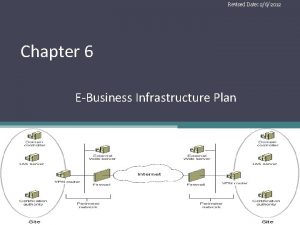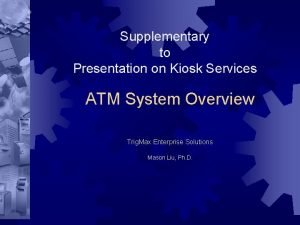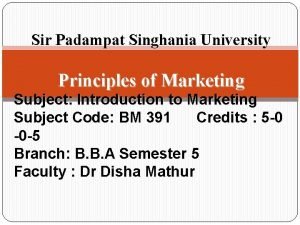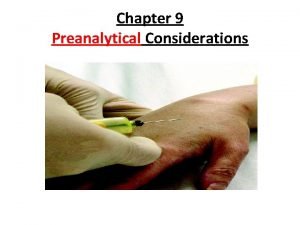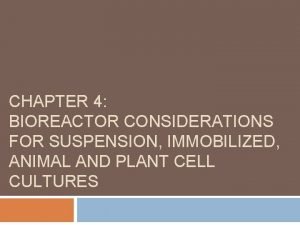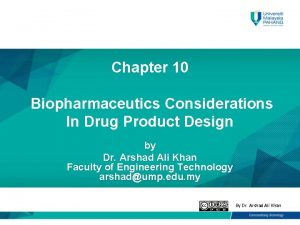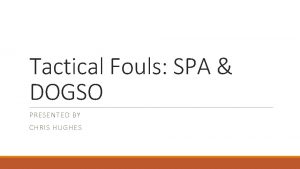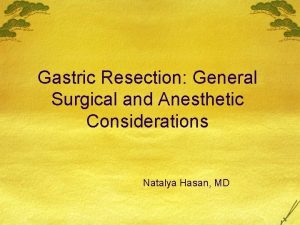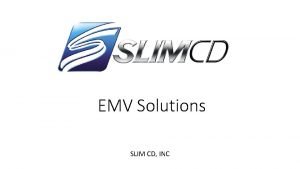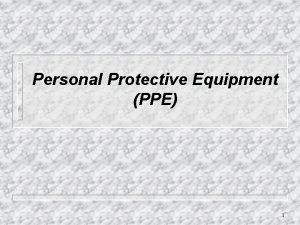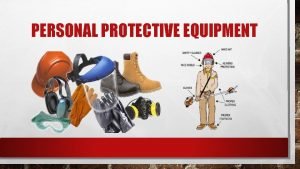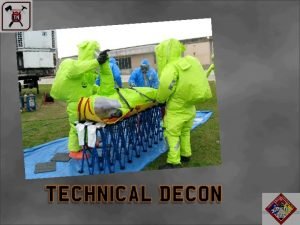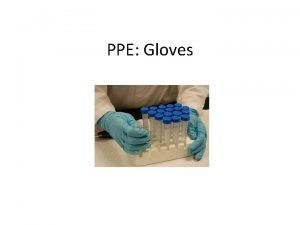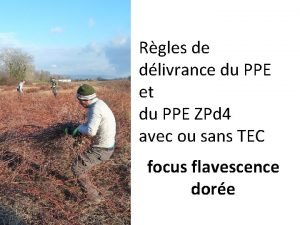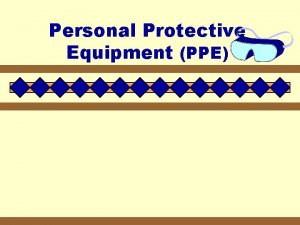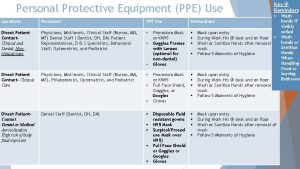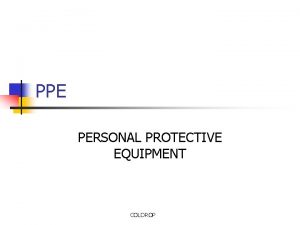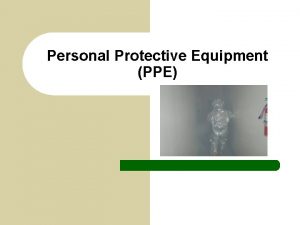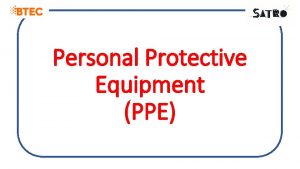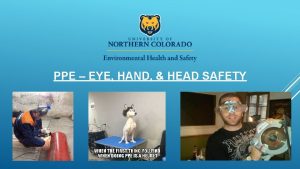HS considerations for PPE Group Infrastructure issues and



























- Slides: 27

H&S considerations for PPE Group Infrastructure & issues and solutions for ATLAS Upgrade Hybrid/Module strip bonding Health & Safety Induction for PPE Group staff & students

PPE GROUP 13 th May 2016 Fred Doherty, H&S Induction, GU 2

University Online Induction Training • All new members are required to complete the University's Health and Safety Online Induction. The purpose is to ensure they are aware of their health and safety responsibilities and remain safe during the course of their work. • It is important that management units also take steps to formalise the information given to new members, by their immediate manager or local Safety Coordinator, by having a local safety induction. This should include site orientation, fire evacuation procedures, accident reporting, location of first aiders, site rules and results of any risk assessments that have been undertaken. • Records of this training must be kept as evidence that this training has been given and to assist in identifying any future training. 13 th May 2016 Fred Doherty, H&S Induction, GU 3

Table of contents Presentation plan Group Safety – Personnel /Training / Personal Safety Induction & Training Personal Review Spreadsheet Glasgow University Online E- Induction Fire Safety Wardens / Assembly Points / Evacuation Accident or illness First Aid GLADD Cleanroom Procedures Safety for possible work requirement areas Heavy Lifting / Working at Heights / Gas / HV / Radiation / X-Rays / Chemicals / Cryogenics / Lasers Working Outwith Normal Hours Safety & Travel - Fieldwork 13 th May 2016 Fred Doherty, H&S Induction, GU 4

Group Safety Personnel Safety Training • • University Health, Safety & Wellbeing E–Induction Valerie Flood – Staff Induction Coordinator. • PPE Group Safety Induction talk. Fiona Grant - First Aid Contact. • PPE Group Introductory Pack & tour of labs. Craig Buttar – School Safety Committee. • Further Training when required. • Val O’shea – School Safety Committee • • • Fred Doherty - PPE Group Safety. Personal Safety Outcome • Induction & Introductory pack will cover general basics of safety and areas relevant to working in the PPE labs. • You should identify your training needs and safety considerations In consultation with your supervisor. • Ongoing assessments with supervisors, safety personnel and annual PDRs should clarify requirements for each individual. 13 th May 2016 Fred Doherty, H&S Induction, GU 5

Induction & Training Review Spreadsheet Personal Induction & Training Review Spreadsheet 13 th May 2016 Fred Doherty, H&S Induction, GU Meeting 6

Induction & Training Review Spreadsheet Personal Induction & Training Review Spreadsheet 13 th May 2016 Fred Doherty, H&S Induction, GU Meeting 7

HR New Staff Online E-Induction Glasgow University New Staff Online E- Induction 13 th May 2016 Fred Doherty, H&S Induction, GU 8

E – Induction Overview & Quiz E- Induction Overview Safety & Environmental Protection Services, Occupational Health & Radiation Protection 13 th May 2016 Fred Doherty, H&S Induction, GU 9

Kelvin Building Fire Wardens Area Fire Officer Mr Colin Craig Ext 5901 or 07748155509 Deputy Fire Officer Ms Agnes Garrett Ext 6400 Old Building Fire Wardens Area Covered Mike Perreur-Lloyd Ms Valerie Flood Steven O’Shea Jenny Anderson Dr Bryan Barr Dr Morag Casey Iain Sim Mr Gordon Smith Dr Graham Gibson East Perimeter West Perimeter Computer Lab West Perimeter East Perimeter Level 4 # Level 3 # Level 2 Level 1# Exit via Old Building (South Entrance) - Assembly Point 3 13 th May 2016 Fred Doherty, H&S Induction, GU 10

Kelvin Building – Fire Assembly Points PPE Group - Site Orientation 13 th May 2016 Fred Doherty, H&S Induction, GU 11

Kelvin Building Fire Evacuation • You should familiarise yourself with the escape routes from the premises & position and operation of Fire Alarm Call Points. On Discovering a Fire: • Raise the alarm by operating the nearest Fire Alarm Call Point an electronic sounder will then sound continuously. • Evacuate the building by proceeding to the designated assembly point On Hearing a Warning of Fire • Evacuate the building quickly and calmly (Proceed to the designated assembly point) 13 th May 2016 Fred Doherty, H&S Induction, GU 12

Kelvin Building Fire Evacuation On Both Occasions: Do not delay your departure by collecting personal belongings Where possible close room doors behind you Do not use lifts Do not re-enter the building until a Fire & Rescue Officer has stated that it is safe to do so. Do not fight a fire if: It is dangerous to do so You are on your own There is a possibility of your escape route being cut off by fire or smoke The fire continues to grow The fire involves hazardous materials If in doubt get out 13 th May 2016 Fred Doherty, H&S Induction, GU 13

Accident or Illness - First Aiders Accident or Illness • In the event of a serious accident or sudden illness you should dial 4444 and ask for an ambulance then summon a first-aider. • A list of first-aiders is given below. • If the accident involves chemicals, full written details should be sent with the patient. • In the event of a less serious accident or illness you should summon a first-aider. If the firstaider decides that hospital treatment is required then contact Main Gatehouse to call an ambulance. If no first-aider is available contact Main Gatehouse Ext 4282 and First Aid trained Security Staff will attend. Kelvin Building First Aiders • Mr P Barbour • Mr S Craig • Mr D Doak • Mr A Hood • Mrs F Grant Room 515 b Room 203 Room 140 Room 339 Ext 4466 Ext 5901 Ext 6412 Ext 6423 Location of First Aid Boxes • Level 1 : • Level 2 : • Level 3 : • Level 5 : Room 148 Janitor's Desk and Rooms 203, 206 and 216 Room 319, 339 and 350 Room 515 b 13 th May 2016 Fred Doherty, H&S Induction, GU 14

Glasgow Advanced Detector Development Clean Room Facility - GLADD Main Cleanroom Procedures • • The clean room is a restricted area; only TRAINED and AUTHORISED users may enter. No more than 6 PEOPLE should be in this laboratory at any one time. DOORS should not be held open longer than necessary. There should be NO EATING, DRINKING or CHEWING GUM in the clean room. Use of PHONES is prohibited. Full clean room ATTIRE MUST ALWAYS be worn in the clean room. EXCEPT IN CASE OF EMERGENCY, such as fire alarm or evacuation, personnel should not wear CLEAN ROOM ATTIRE outside of the clean room/changing area. NO FIXTURE OR EQUIPMENT should be brought into the clean room without prior approval. 13 th May 2016 Fred Doherty, H&S Induction, GU 15

HEAVY LIFTING • • The regulations do not specify safe weights because capability is so variable. Figure 1 provides a guide to the reduction in capability when lifting loads to different heights and distances from the body. It assumes a 25 kg load to be within a mans capability when a simple straight lift to waist height is involved. No single person should be required to lift, lower or carry loads over 25 kg. This limit would only apply when the load is within the individuals capabilities and when no other risk factors are present e. g. bending IF EVER IN DOUBT USE A TROLLEY FROM STORES OR ASK FOR ASSISTANCE. IF LIFTING BEND YOUR KNEES NOT YOUR BACK AND KEEP LOAD CLOSE. THINK DISTANCE TO BE MOVED, SIZE & SHAPE, WORKING ENVIRONMENT, FITNESS, REPETITION. HEAVY GAS CYLINDERS SHOULD ONLY BE MOVED BY TECHNICAL STAFF. ALWAYS WEAR SAFETY SHOES WHEN MOVING HEAVY LOADS. GLASGOW LINKS : http: //www. gla. ac. uk/services/seps/az/manualhandling/ HSE LINKS : http: //www. hse. gov. uk/msd/faq-manhand. htm 13 th May 2016 Fred Doherty, H&S Induction, GU 16

WORKING AT HEIGHTS • • • . Within the PPE Group labs there should be no requirement to work at height. All lab experiments / research are normally bench height based. There is provision of step/work stools throughout the labs for access to hard to get to electrical overhead sockets and service connections in the GLADD Cleanroom. If working at height at CERN, training courses are provided there. Supervisors should ascertain whether working at heights may be involved in any work at other external sites and arrange suitable training at that site or here at Glasgow. The Regulations set out a hierarchy of control measures which duty holders are required to follow when planning work at height: Avoid working at height if possible Prevent falls through: use of an existing safe place of work or means of access use of the most suitable way of working selection of the most suitable work equipment Minimise the distance and consequences of a fall should one occur. The provision of information, instruction and training, where necessary, is also an important factor Glasgow Link: http: //www. gla. ac. uk/services/seps/az/workatheight/ Useful information on the prevention of falls from height is available from the HSE website at http: //www. hse. gov. uk/falls/index. htm 13 th May 2016 Fred Doherty, H&S Induction, GU 17

Gas Safety • Only technical staff should be involved in the safe handling, installation & storage of gas cylinders. • New Nitrogen larger 300 bar cylinders are currently in use. These are higher-pressure cylinders for more gas and fewer changeovers. Link : http: //www. boconline. co. uk/en/new-300 -bar-cylinders/index. html • Please see technical staff for guidance on the Regulation / adjustment of gas from all group cylinders. • Nitrogen Gas is currently distributed to the GLADD facility from lab 345. • Carbon dioxide is also being used in lab 345 for the ATLAS upgrade cooling project This system has been risk assessed with input from the school safety committee (Peter Barbour) and safety features put in place within the area including gas monitors with audible alarms in both the lab and outside corridor, automatic window fan extraction in the case of a gas leak, lab door vents and warning sign at entry to lab. • Nitrogen and Carbon Dioxide have very serious risks including asphyxiation if there is a gas leak (they do not support life, hence the precautions taken above). 13 th May 2016 Fred Doherty, H&S Induction, GU 18

Electrical Safety – High Voltages Main Points • High and low voltage electrical Power Supply Unit sources can be dangerous. Never use exposed electrical wires in research setups. Ensure all wires and connectors are insulated and have insulation rated for the maximum applied bias. • All High voltage supplies used in labs are usually supplied by companies such as Keithley, RS & Farnell. These will have user guides for safe use. • Know your cable type when putting experiments together. Never exceed cable / interconnect specified working parameters. • Inform technical staff of any problems concerning electrical equipment within the lab. Do not go ahead and modify or try to repair the equipment yourself • All electrical units including HV units are PAT (Portable Appliance Testing) tested and labelled. • If in any doubt about electrical work you will be undertaking please contact your supervisor or a member of technical staff. 13 th May 2016 Fred Doherty, H&S Induction, GU 19

Radiation Safety • Ionising radiation is dangerous and can cause cancer. Exposure can go unnoticed at the time of use and may only be years later that the effects of reduced life expectancy and quality of life are experienced. Therefore it is of the upmost importance to be extremely careful in their use for your own safety and the safety of others • Irradiated material (or unknown materials) intended to be taken into the PPE group labs will be checked first by the Radiation Protection Officer, before being allowed into the lab for use and storage. This irradiated material should be stored in the large storage safe located in Semi Clean Room 341 a. • All experiments and demonstrations involving the use of ionising radiation should be carefully prepared with a view to minimising radiation exposure at all times • Adequate supervision of undergraduates must be provided and instruction in correct handling techniques with a brief explanation of the hazards involved should precede the actual experiment. • Basic rules would include - don’t look into them, don’t point at others, and don’t touch the radioactive part of the source. • Radiation source notices are available to accompany sources signed out from the safe. They are to be used to indicate visually to others (cleaners, janitors, visitor, etc. ) that there are radioactive sources currently being used in particular areas of the labs. • All sources used in research laboratories must be returned to secure storage directly after use (unless completely necessary sources should be signed back in at the end of the day and over lunch breaks). 13 th May 2016 Fred Doherty, H&S Induction, GU 20

X-RAY SAFETY XX-RAY APPARATUS • • All work with ionizing radiation must be carried out in accordance with the procedures laid down in the "Local Rules for the use of Radioactive Materials and X-Rays". This document should be read in conjunction with Note No. 8 in the booklet "Health Physics Notes" issued by the University Radiation Protection Service. Copies of these documents may be obtained from the Radiation Protection Supervisor (Peter Barbour). All uses of X-ray equipment must be discussed beforehand with the Radiation Protection Supervisor. X-ray apparatus should be completely enclosed (including the useful beam) in protective shielding such that the dose rate does not exceed 5 μSvh-1 at a distance of 5 cm from the shielding at the maximum operating conditions of the set. Interlocks should be provided to shut off the useful beam if the shielding is removed. The group currently have 2 X-ray systems in lab 341. The smaller 70 k. V 8 m. A Planmeca Intra dental X-ray unit and the much larger 100 k. V 75 m. A Gulmay CP 104/1 X-Ray Generator. Local Rules for the use of Radioactive Materials & X-Rays: http: //www. gla. ac. uk/media_383368_en. pdf / Health Physics Notes - Note No. 8: http: //www. gla. ac. uk/media_301839_en. pdf / Radiation Protection Services: http: //www. gla. ac. uk/services/radiationprotection/ 13 th May 2016 Fred Doherty, H&S Induction, GU 21

Chemical Safety • The use of chemicals within the labs should be kept to a minimum. Hazards increase with the quantity stored. • Anyone intending to introduce a chemical substance into the Group should obtain as much information as possible concerning the hazards associated. If the hazards are considerable, the availability of a safer alternative substance should be investigated • There will be provision of a deionised water supply and chemical sumps within the GLADD Cleanroom for waste chemicals. • You should wear the appropriate recommended protection for chemical(s) used be they gloves, glasses, respirator, protective clothing etc. • Control of Substances Hazardous to Health (COSHH) forms and working procedures are required for the safe use of many chemicals used for group activities. Please see myself if planning new activities requiring COSHH. 13 th May 2016 Fred Doherty, H&S Induction, GU 22

Cryogenics Safety • Cryogenics within our groups current research would only include the Carbon Dioxide (Liquid withdrawal) based cooling system in lab 345 used for ATLAS upgrade cooling experiments. • As mentioned in the Gas section it has been risk assessed mainly for the possible serious risk of asphyxiation in the event of a gas leak but the system cooling pipework is also insulated and enclosed where possible to protect users from low temperatures. • Liquid nitrogen is occasionally used within the group therefore personal protective equipment (PPE) must be worn when handling cryogenics. This could include gloves, apron/overalls, face shield and appropriate shoes. • For further guidance on use of Cryogenic Substances please refer to : http: //www. gla. ac. uk/services/seps/az/cryogenicsubstances/ • if in any doubt about Cryogenic work you will be undertaking please contact your supervisor or a member of technical staff. 13 th May 2016 Fred Doherty, H&S Induction, GU 23

LASER SAFETY • • • The current School Laser Supervisor for the School is Dr Graham Gibson (ext 0894). All new laser equipment should be registered with him and the siting and use of lasers in the School should also be discussed with him. Registered laser operators are encouraged to complete the RPS Laser Safety Course. Staff must exercise the strictest control and take all necessary precautions when using lasers. The necessary precautions are summarised in the University Safety Handbook. Research laboratory areas in which lasers are operating usually have illuminated warning signs outside them and it is important that these are switched on when the lasers are in operation, and are switched off when the lasers are inoperative. In general, a laser should not be left operating in an unoccupied room unless an interlock system, which shuts off the laser in the event of an unauthorized entry, is installed. In view of the exceptionally low maximum values for exposure, the following basic methods of protection must be considered: Complete containment of the laser installation. Screening of the operator. Direct protection of the eyes. Assessment of the installation for safety before the start of operations. The designation, instruction and medical control of staff for laser work. • • Full recommendations for the safe operation of laser systems will be found in the Laser Rules on laser safety obtainable from the Laser Supervisor. SCHOOL LINK : http: //www. gla. ac. uk/media_383368_en. pdf / UNIVERSITY LINK : http: //www. gla. ac. uk/services/radiationprotection/non-ionisingradiations/ RPS Laser Safety Course. - http: //www. gla. ac. uk/services/radiationprotection/lasersafetycourse/ 13 th May 2016 Fred Doherty, H&S Induction, GU 24

Working Outwith Normal Hours • It is important that you comply with the following instructions when working out with normal hours: • Record your arrival and departure in the log book provided at the basement entrance. Plan what you are doing to reduce the risk of fire to a minimum. Acquaint yourself with the whereabouts of the nearest exit, fire extinguisher, and light switches for corridors and stairs leading to the nearest exit. • • • Potentially dangerous operations must never be undertaken out with normal hours unless a second responsible person is present. Such operations should be restricted to normal hours when medical and other services are readily available. • Research students who intend to work late must inform a senior member of the group, and give details of the work they intend to do. • It is strongly advised that inexperienced personnel should be accompanied by experienced personnel when working late. If there is a serious injury, dial 4444 and ask for an ambulance. If no First Aider is available in Kelvin Building contact Main Gatehouse Ext 4282 and First Aid trained Security Staff will attend. 13 th May 2016 Fred Doherty, H&S Induction, GU 25

SAFETY & TRAVEL - FIELDWORK Safety & Travel - Working away from the University • When staff are working away from the University, Research Group Leaders (RGL) are responsible for ensuring a safe working environment. In general, work will be carried out in another institution that the RGL is familiar with and has similar levels of safety to the University of Glasgow. • If staff are planning to undertake fieldwork or are going to a new institution they should undertake a risk assessment and discuss with their RGL. • It is the responsibility of the line manager (or other identified member of staff) to ensure that the employee is as well prepared for the trip as possible. 13 th May 2016 Fred Doherty, H&S Induction, GU 26

 Five-layer model of e business infrastructure
Five-layer model of e business infrastructure Layers of e commerce infrastructure
Layers of e commerce infrastructure Estate and infrastructure group
Estate and infrastructure group Writing strategies and ethical considerations
Writing strategies and ethical considerations Ethical considerations in experimental research
Ethical considerations in experimental research Pricing considerations and approaches
Pricing considerations and approaches Appropriate infrastructure development group
Appropriate infrastructure development group Durite
Durite Tax considerations for setting up a new business
Tax considerations for setting up a new business Atm kiosk solution
Atm kiosk solution Exchange transaction and relationship in marketing
Exchange transaction and relationship in marketing Mechanical considerations of transmission line
Mechanical considerations of transmission line Database design considerations
Database design considerations Contrasting acquisition
Contrasting acquisition Cloud delivery model considerations
Cloud delivery model considerations Pre analytical considerations in phlebotomy
Pre analytical considerations in phlebotomy Bioreactor considerations for animal cell culture
Bioreactor considerations for animal cell culture Collaboration design considerations
Collaboration design considerations Mechanical principles of tooth preparation
Mechanical principles of tooth preparation Antecubial region
Antecubial region Biopharmaceutic considerations in drug product design
Biopharmaceutic considerations in drug product design Mandibular impression landmarks
Mandibular impression landmarks Dogso vs spa
Dogso vs spa Considerations icon
Considerations icon Acclimatisation pdhpe
Acclimatisation pdhpe Gastrectomy anesthesia considerations
Gastrectomy anesthesia considerations Capk file expired
Capk file expired Design considerations for mobile computing
Design considerations for mobile computing
